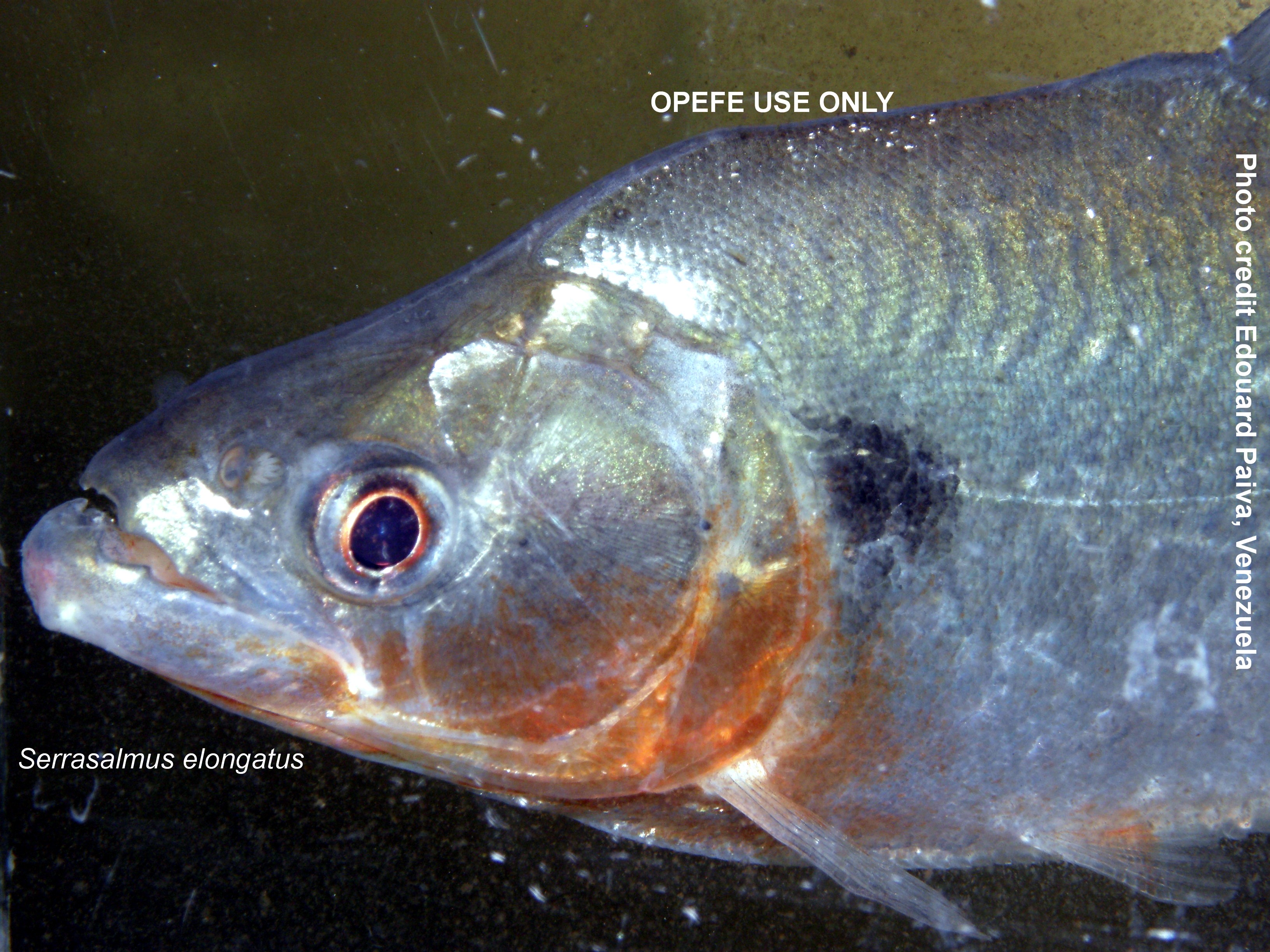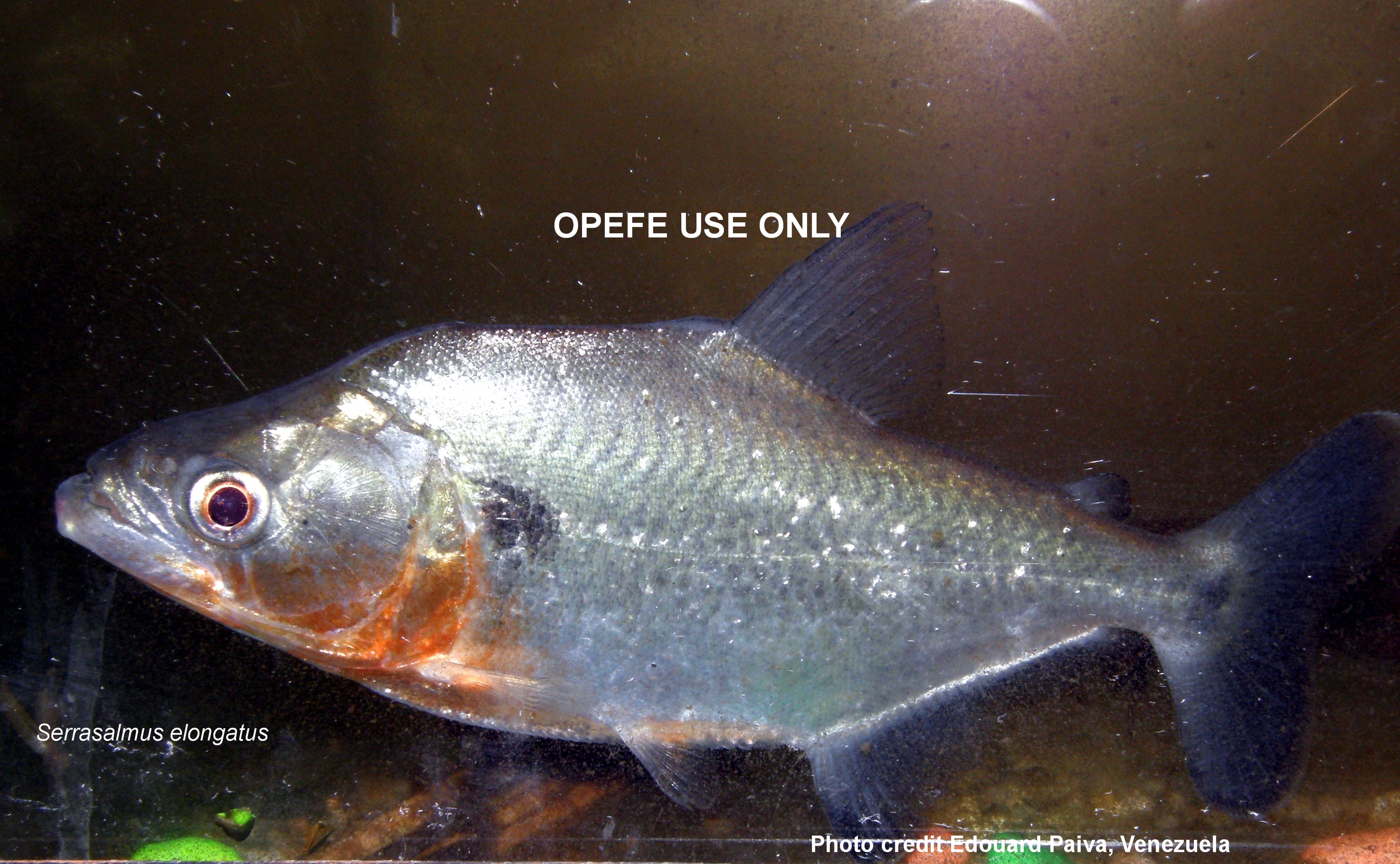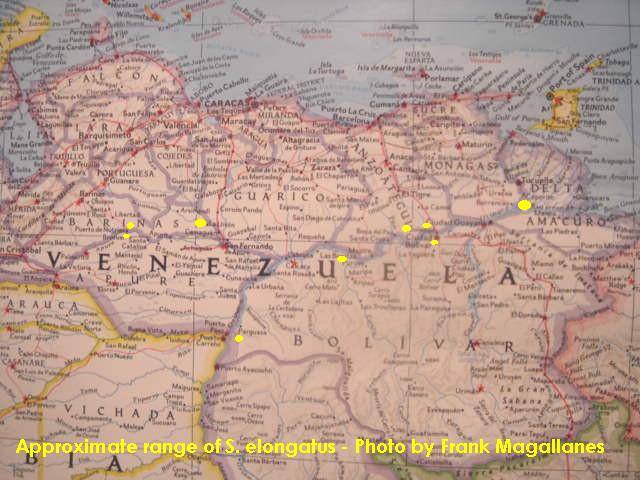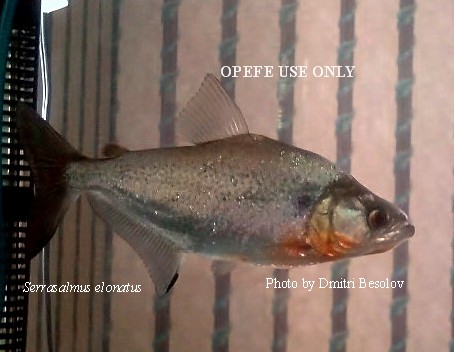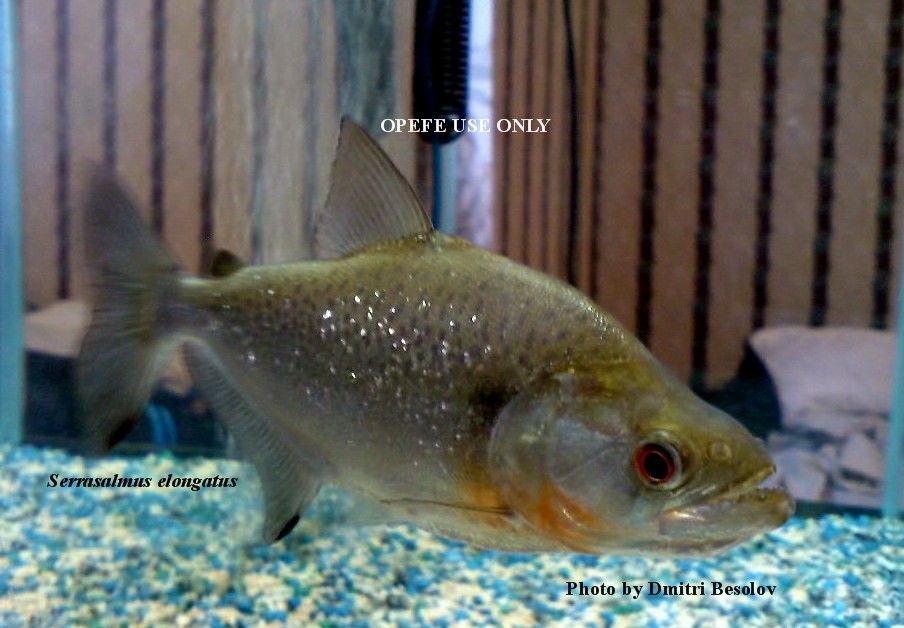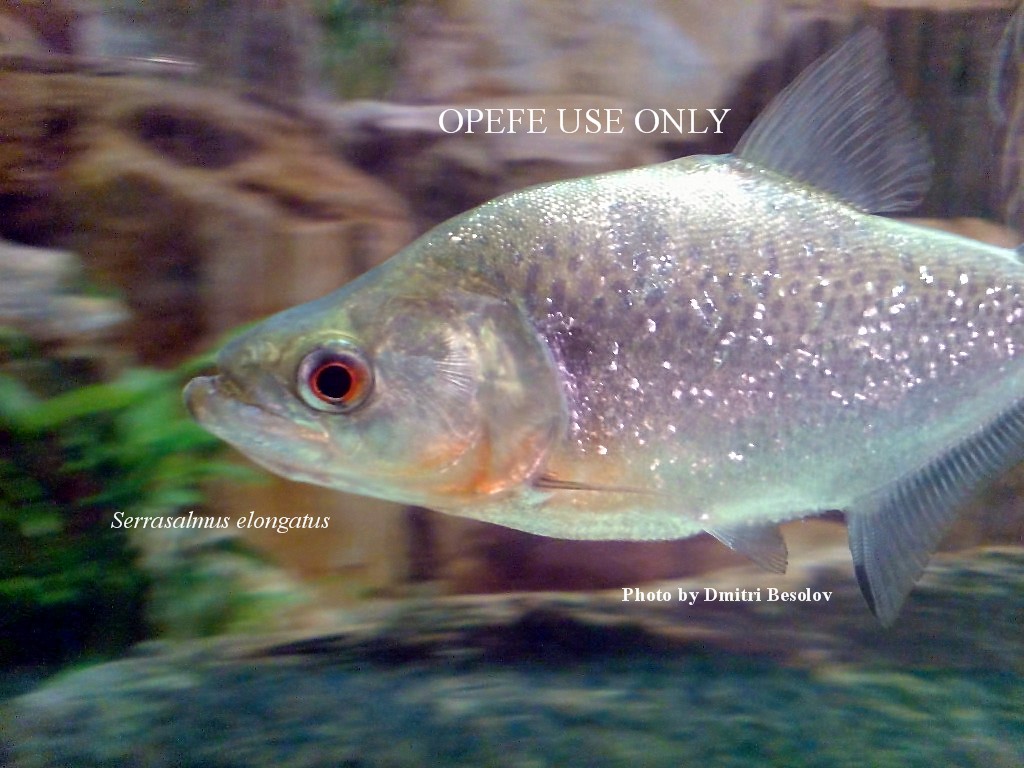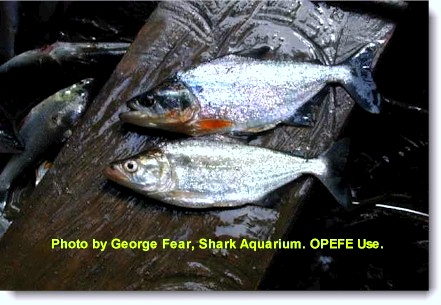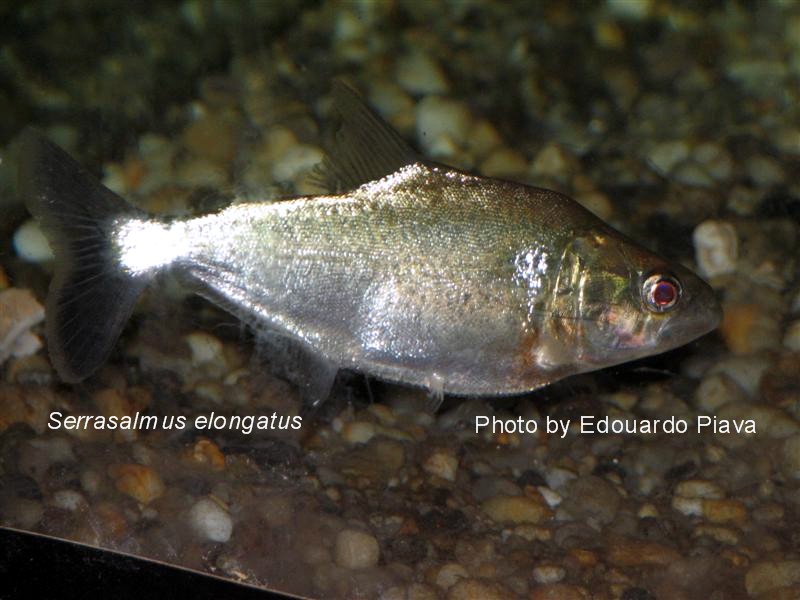FROM FRANK MAGALLANES
Recommend
keeping as solitary species in home aquarium. The species is an ambush predator
and does not use stealth to bite its prey. This torpedo shaped piranha is the
only elongated species of its kind. They are notorious fin biters and should be
kept alone in the aquarium. There is some concern about this fishes
"elongated form." Depending on the locality this fish may appear more
rhomboid than elongated. Historically, it was supposed to be sexually dimorphic
based on an anal fin blemish. I have not had the opportunity to investigate this
species completely as specimens are rarely imported for the aquarium trade.
Those that are imported command high prices from the pet trade.
The
species is not very prolific and very little is known about the habits during
the first stages of the development, nonetheless, the few obtained the data
demonstrate it to be principally a predator from early age consuming fins and
scales of other fish. The adults are found in deep, white water of the main
channels. The juveniles are frequently found in black and white waters and are
generally associated with lagoons of floating aquatic plants. The breeding of
this species has not been accomplished by hobbyists. The species is very rare
and its actual requirements are not known. However, there is some material
(compiled here) that may be of some use to hobbyists wishing to try breeding
this species. Light requirements (moderate) would probably be the same as those
found in Llanos of Venezuela. Orinoco rivers: pH: 4.5-7 (6.0); 2-8 dH (6);
75-82°F (24-28°C). Because this species has never been bred in captivity, it
is my recommendation that a 200 gallon or larger tank be used. Also suggest
heavy planting (back and sides) of the tank with a gravel and sand mixed tank be
used. Filtration should be heavy on one side (power head) and moderate on the
other (wet/dry system recommended). I base my recommendation on the
"bigger" tank theory because it remains unknown what the minimum tank
size would be for this species which is more rhombeus-like in its habits.
S. rhombeus is found in open rivers and this fish is too. Water changes,
while important is not as important as keeping the water stable and within the
parameters suggested above. These torpedo-shaped fishes need fast current, yet
requirements for breeding are like those of other piranhas. S. elongatus
lives in the flooded forest where they are frequently found. As an adult they
are generally found in large rivers or found in huge permanent lagoons. The area
also undergoes a period of a dry season from October - March. The rainy season
runs from April - September.
Characiformes
usually are visually-oriented diurnal fishes with large eyes; they dwell in
well-lit surface waters (Lowe-McConnell 1975, Fink & Fink 1979, Moyle &
Cech 1996). In contrast, catfishes are primarily nocturnal and have sensory
adaptations (e.g. tactile and chemical receptors) to low visibility (Hara 1971,
Lowe-McConnell 1975, Fink & Fink 1979). Another problem with these types of
fish is that they are fin biters and you may lose some specimens (due to
predation) before anything significant happens in your aquarium. Like the vast
majority of piranhas, the breeding process can be very bloody and pieces of
flesh or fins will be part of the process. But in the end you will have
accomplished a most rare occurrence for the home aquarium.
SCIENCE
 Historically, the species was placed as a member of
the humeralis group (Géry, 1976), known then as S. pingke. The
group consisted of; S. gibbus [see inset left] (Castelnau, 1855), S.
humeralis (Eigenmann, 1915) and S. pingke (Fernández-Yépez, 1951).
Morph-metrically these species appear similar. Member of these clade had
included; S. humeralis (synonym S. iridopsis, COPE, 1871), S.
eigenmanni (Norman, 1929), S. elongatus (Kner, 1860) and S.
nalseni (Fernández-Yépez, 1951). Mago-Leccia (1990) placed S. pingke
as a distinct species from S. elongatus in genus Serrasalmus from
Venezuela. Machado-Allison and Fink (1996) examined plenty examples of Serrasalmus
pingke including juvenile forms (54.0 and 58.0 mm SL). The morphometric
counts and other characters are very incomplete. Serrasalmus elongatus
was compared with S. rhombeus and they are different in coloration, anal
fin rays, number of spines and other characters, including a large pre-dorsal
spine. Some juveniles of S. irritans are elongated at the early stages of
life, but even so, they are not as elongated as S. elongatus and this is
placed as the valid species name. Michel Jégu compared S. gibbus with
S. elongatus and while both species appeared similar in certain characters,
Jégu placed S. gibbus as a distinct species separate from S.
elongatus. New morph types of S. rhombeus are being discovered that
may very well exclude S. gibbus as a valid species name. S. rhombeus
is a very complex species that is appearing in different body shapes, including
elongated forms but not as elongated as S. elongatus, which remains a
valid distinctive species.
Historically, the species was placed as a member of
the humeralis group (Géry, 1976), known then as S. pingke. The
group consisted of; S. gibbus [see inset left] (Castelnau, 1855), S.
humeralis (Eigenmann, 1915) and S. pingke (Fernández-Yépez, 1951).
Morph-metrically these species appear similar. Member of these clade had
included; S. humeralis (synonym S. iridopsis, COPE, 1871), S.
eigenmanni (Norman, 1929), S. elongatus (Kner, 1860) and S.
nalseni (Fernández-Yépez, 1951). Mago-Leccia (1990) placed S. pingke
as a distinct species from S. elongatus in genus Serrasalmus from
Venezuela. Machado-Allison and Fink (1996) examined plenty examples of Serrasalmus
pingke including juvenile forms (54.0 and 58.0 mm SL). The morphometric
counts and other characters are very incomplete. Serrasalmus elongatus
was compared with S. rhombeus and they are different in coloration, anal
fin rays, number of spines and other characters, including a large pre-dorsal
spine. Some juveniles of S. irritans are elongated at the early stages of
life, but even so, they are not as elongated as S. elongatus and this is
placed as the valid species name. Michel Jégu compared S. gibbus with
S. elongatus and while both species appeared similar in certain characters,
Jégu placed S. gibbus as a distinct species separate from S.
elongatus. New morph types of S. rhombeus are being discovered that
may very well exclude S. gibbus as a valid species name. S. rhombeus
is a very complex species that is appearing in different body shapes, including
elongated forms but not as elongated as S. elongatus, which remains a
valid distinctive species.
S.
pingke was originally described from Río Apure, La Defensa, suroeste de San
Fernando de Apure, Estado Apure, Venezuela. Later authors put it in Brazil and
other regions because of the confusion with S. elongatus.
According
to Antonio Machado-Allison he said the following comments regarding Jegu
comments on S. pinkge being a valid species and the assertion of Heiko
Bleher email submitted by a pseudo hobbyist:
ANTONIO
MACHADO-ALLISON
Well. They are
wrong. S. pingke is based in a very young specimen. As Fink and I pointed out
there were no doubt that is the juvenile form of S. elongatus based in the
revision of other specimens in museums (Machado-Allison and Fink, 1996). If
Jegu is right, he has to find a older specimen different from S. elongatus in
Venezuela, where supposed is distributed S. pingke.
Even collections
made by us in the type locality, showed only adult forms of S. elongatus
nothing else.
Antonio finished up
with: I think the problem
is that some people do not believe in Spanish speaking scientist or they do not
(read) scientific paper written in Spanish. They have to move to modern world
where they have to read in Spanish and Portuguese if they want to study fish in
South America
S.
elongatus was described from Rio Guapore, Mato Grosso, Brazil. But is now
considered widespread in Bolivia, Brazil, Ecuador, Peru and Venezuela.
DIET
Parts
of fish and scales mostly.
COLOR
OF LIFE
Juveniles
are generally silvery-green on the body without distinctive spots or marks with
an exception being a dark blemish found the caudal of some specimens. The fins
are hyaline and transparent. In adults the body is generally bright silvery in
the dorsal-lateral and posterior of the body. The pectoral and pelvic fins are
orange to fiery red. A black blemish (the diameter of the eye) is found in the
humeral region near the first few scales of the lateral line. The head is dark
dorsally; silver with yellow and orange coloration on the regions of the
ventral-lateral and mandible. The orbit (eye) is red. The dorsal and anal fin
are gray. The anal fin has a dark band distally from the first primary rays. The
caudal and adipose fin are very dark in adults of large size. Small specimens
have the adipose fin more hyaline. The pectoral and pelvic fins are colored red
to orange tinting. (Machado-Allison and Fink, 1996).
LOCALITY
Amazon
and Orinoco River basins
-
Rio
Guaraiquito, Laguna La Yuca, GU
-
Rio
Apure, Caño Los Zorros, Boquerones, AP
-
Rio
Chimire, Paso Chimire, GU
-
Rio
San José, GU
-
Rio
Apure, Viejo, AP
-
Caño
El Rodeo, 100 K. E. Est Gas, AP
-
Hato
Santa Rosa, Esteros de Camaguán, GU
-
Carretera
Guayabal, GU
-
Lag.
La Raya, Cano Falcón, GU
-
Rio
Apure, Las Guanotas, AP
-
Laugun
Terecaya, Soledad, AN
-
Caño
Falcon, La Raya, Camaguán, GU
-
Rio
San José, El Polvero, GU
-
Caño
Guaraguapo. afl, Rio Orinoco, DA
MAXIMUM
SIZE
-
Machado-Allison,
Antonio., Fink, William., 1996 Los Peces Caribes de Venezuela, Diagnosis,
Claves, Aspectos Ecologicos Y Evolutivos.
-
Jégu,
Michel, (1988) Le genre Serrasalmus (Pisces, Serrasalmidae) dans le bas
Tocantins (Brésil, Parà).
-
Fernández
Yépez, A. . 1951 Evencias/Contribuciones ocasionales de la Colección
Ictiologica Agustín Fernández Yépez. «Serrasalmus pingke», un nuevo
serrasalmido para la fauna neotropical. Evencias. (12):1-3 unnum.
-
Kner,
R. 1858 Zur Familie der Characinen. Sitzungsber. Akad. Wiss. Wien
v. 32 (no. 22): 163-168. [Abstract of Kner 1860.]
-
Kner,
R. 1860 Zur Familie der Characinen. III. Folge. Der
Ichthyologischen Beiträge. Denkschr. Akad. Wiss. Wien v. 18: 9-62, Pls. 1-8.
[Also as a separate, pp. 1-54, with dual pagination. Some taxa appeared first
in Kner 1858.
-
Ortega,
H. and R. P. Vari 1986 (10 Oct.) Annotated checklist of the
freshwater fishes of Peru. Smithson. Contrib. Zool. No. 437: iii + 25 p.
-
Fernández-Yépez,
A. 1951 (Aug.) Serrasalmus pingke, un nuevo Serrasalmido para la
fauna Neotropical. Evencias No. 12: 3 unnumbered.
-
Lasso,
C. A., V. Ponte and Oscar M. Lasso 1997 Catálogo de la colección
de tipos de peces de la Fundación La Salle de Ciencias naturales. Parte I:
Museo de Historia Natural la Salle (MHNLS). Memoria, Soc. Cienc. Nat. La Salle
v. 57 (no. 147): 37-52.
-
Machado-Allison,
Antonio., Fink, William., 1996 Los Peces Caribes de Venezuela, Diagnosis,
Claves, Aspectos Ecologicos Y Evolutivos.
-
Goulding,
Michael, 1980 The Fishes and The Forest, Explorations in the Amazonian Natural
History. University of California Press Berkely, Los Angeles London.
USE YOUR BACKSPACE TO RETURN OR CLICK HERE TO RETURN
SERRASALMUS LIST
USE THIS LINK TO RETURN TO
RESEARCH PAGE.
The
OPEFE web site and its contents; is disclaimed for purposes of Zoological
Nomenclature in accordance with the International Code of Zoological
Nomenclature, Fourth Edition, Article 8.3 and 8.4. No new names or nomenclature
changes are available from statements at this web site.
Copyright©
1994-2012 Oregon Piranha Exotic Fish Exhibit (The OPEFE fish exhibit is
permanently CLOSED as of 2000) Sutherlin, Oregon. Information posted on this web
site is archival data on fish scientific classifications and other information.
DISCLAIMER: The copyrighted material may not be used for any purpose other than
private study, scholarship or research. Cited information requires credit and
this link www.opefe.com. All rights reserved. All images shown (unless
otherwise noted) is property of OPEFE.
UPDATED:
12/05/2015
